Sigma 18-50mm f/2.8 DC DN Contemporary lens announced: APS-C mirrorless lens makes a strong first impression
posted Tuesday, October 19, 2021 at 8:29 AM EDT
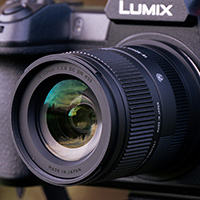
Sigma has announced its first mirrorless-exclusive APS-C standard zoom lens, the Sigma 18-50mm f/2.8 DC DN Contemporary. The compact lens offers a full-frame equivalent zoom range of 27-75mm with a constant f/2.8 aperture. We were able to go hands-on with the L-mount version ahead of today's announcement, although the lens is also coming in an E-mount version.
Hands-on with the Sigma 18-50mm f/2.8 DC DN Contemporary lens
The lens is compact and light, weighing only 290g (10 oz.). It's the smallest and lightest f/2.8 standard zoom lens for crop-sensor mirrorless cameras. At 18mm, the lens is 74.5mm (2.9") long, but it does extend slightly as you zoom. It's quite narrow, as well, with a maximum diameter of 65.4mm (2.6"). The lens has a 55mm filter thread. As you zoom, the lens extends, but the filter thread doesn't rotate, which is nice when using a polarizing filter.
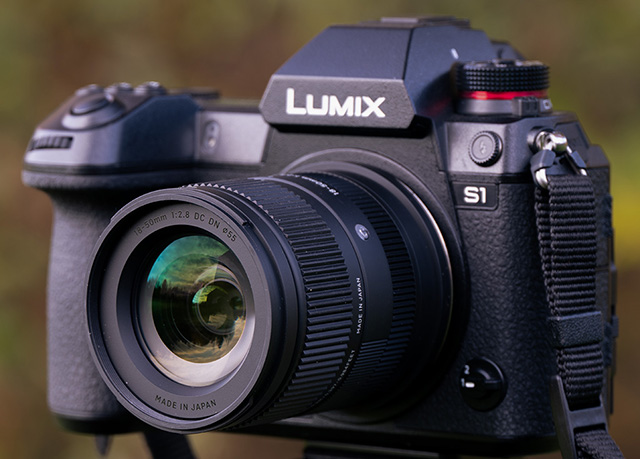
In use, the lens feels good. Despite being lightweight and compact, the lens feels quite robust. It is built using Sigma's Thermally Stable Composite (TSC), resulting in a sleek, sturdy and lightweight design. Sigma's TSC has a thermal conductivity similar to aluminum, resulting in stable performance and operability across a wide temperature range. Some of the internal structure of the lens is built using metal for enhanced durability. In terms of weather sealing, the mount has a dust- and splash-resistant design.
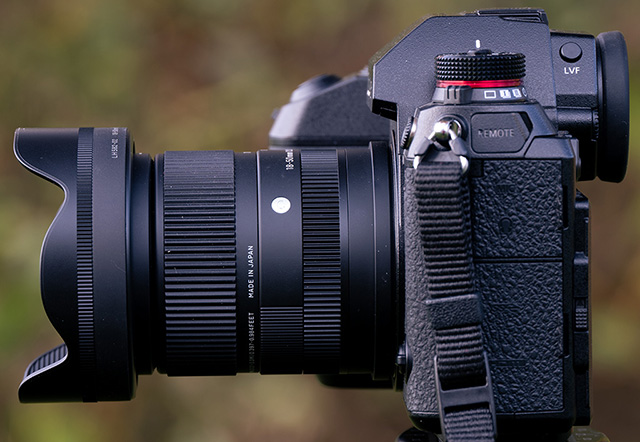
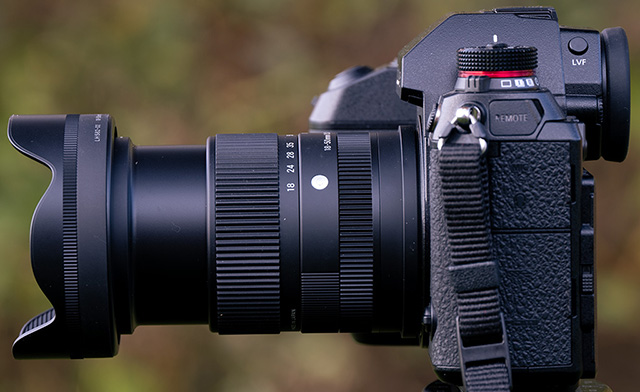
Since the lens barrel is short, there's not a lot of space for the zoom ring and focus ring. Nonetheless, the zoom ring is about the width of my thumb and has a ridged surface. It's easy to grip, even when wet, and has painted on focal length markings at 18mm, 24mm, 28mm, 35mm and 50mm. To zoom from 18mm to 50mm takes well under 90° of rotation. Between the lens mount and zoom ring is a narrow focus ring, which is ridged plastic. The focus ring's rotation is quite loose but feels okay.
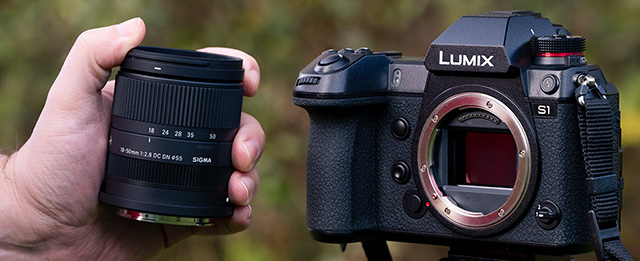
The lens has a removable petal-shaped lens hood. The lens hood screws on with a satisfying locking sound and has a very thin ridged grip area to help the user twist it. The lens hood adds just over an inch of length to the lens. You can reverse it onto the lens for storage, but you wouldn't want to use the lens in this way since the reversed hood covers almost the entire zoom ring.

I used the lens on the full-frame Panasonic S1 camera, which is a large mirrorless camera. I suspect that on a smaller APS-C E-mount camera, the lens would balance nicely. The lens is well-built and feels good in use.

Initial thoughts on image quality
Note: I received an L-mount version of the lens to try ahead of the announcement. Interestingly, the only APS-C camera with an L-mount that's currently in production is the Leica CL. There is also a Leica TL2 with an APS-C sensor, but that's discontinued. The only L-mount camera I had on hand was the Panasonic S1, which is a 24MP full-frame camera. With the APS-C crop, images are quite small. When we do a full review, it will be with a higher-resolution camera.
The lens includes 13 elements across 10 groups. Among these elements are three aspherical elements and a single SLD element. The lens includes Sigma's Super Multi-Layer Coating, as well, and promises minimized flare and ghosting.

While we haven't yet done full image quality testing, the lens seems quite good so far. The lens offers good detail. I noticed that when shooting at f/2.8, there's a bit of a vignette. It goes away as you stop down, but it will be interesting to see if this vignette at f/2.8 persists across the entire zoom range and to take a closer look at overall corner performance.


The 27mm-75mm focal length range is a good one. It works well for many different types of photography. However, when shooting backlit scenes, there's also a bit of visible color fringing. I noticed some longitudinal chromatic aberration (LoCA) (notice the blue and orange edges) and some purple fringing around high-contrast subjects. You can see an example of it below. It's possible that when the lens is fully supported in software like Adobe Camera Raw, profiles will address the chromatic aberration. It can also be handled manually, if needed. Nonetheless, aberrations aren't visible outside of highly-challenging scenes and further testing is required.

Autofocus
The Sigma 18-50mm f/2.8 DC DN C lens has a minimum focus is 12.1cm (4.8") at 18mm and 30cm (11.9") at 50mm, resulting in a maximum magnification of 1:2.8 at the wide end. The working distance is only 2.7cm (1.06") at 18mm, so you should remove the lens hood when working up close. It's an impressive close-focusing distance. The lens also offers pretty nice bokeh via its seven-bladed aperture diaphragm.

The lens uses a stepping motor for autofocus performance, and the resulting AF is quite snappy. The lens focuses quickly and quietly, so the lens should work well for video use in addition to a variety of still photography scenarios.

Price and availability
The Sigma 18-50mm f/2.8 DC DN Contemporary lens will be available around the end of October for $549 USD. The lens is available in E-mount and L-mount versions.

We hope to do a full review of the lens soon, but our initial thoughts are positive for now. The lens has made a good first impression thanks to impressive build quality, a compact and lightweight design and promising optical performance. It's also priced aggressively, which never hurts.